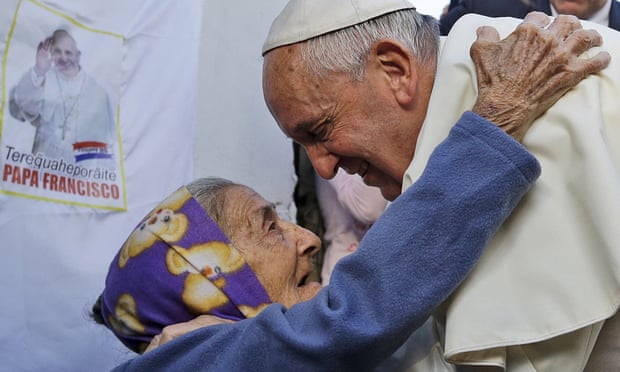ASUNCIÓN, Paraguay— Pope Francis called for a more welcoming Catholic church, open even to those don’t accept its teachings, as he preached at a large open-air Mass on the last day of a weeklong South American tour.
Speaking to hundreds of thousands of people at a military air base on the outskirts of Paraguay’s capital city on Sunday, the pontiff taught a lesson in how the church should—and shouldn’t—attempt to spread the Gospel.
He called for “welcoming those who do not think as we do, who do not have faith or who have lost it, at times through our own fault. Welcoming the persecuted, the unemployed. Welcoming the different cultures, with which this land is so richly blessed. Welcoming sinners.”
The pope’s homily further highlighted his shift in emphasis from that of his immediate predecessor Pope Benedict XVI, who drew clearer lines between the church and secular culture. Emphasizing mercy, especially for the poor, while taking for granted widely contested moral teachings has been a hallmark of Pope Francis’ missionary style, winning him great popularity though unsettling some within the church.
For example, an October, 2014, meeting of bishops that the pope called to consider family issues was the scene of controversy over proposals to make it easier for divorced and remarried Catholics to receive Communion—a practice prohibited by church law. The bishops also debated a recognition of positive aspects of so-called irregular relationships, including those between unmarried or same-sex partners. A second bishops meeting in October will take up the issues again.
“You do not convince people with arguments, strategies or tactics. You convince them by learning how to welcome them,” he said on Sunday. “For that, it is necessary to keep doors open, above all the doors to the heart.”
The Vatican had said the site of Sunday’s speech could accommodate 1 million people, though aerial views showed the area to be far from full.
More than 160,000 people from neighboring Argentina had crossed the border to see the pope, an official said. Among them were President Christina Kirchner, with whom the pontiff had an antagonistic relationship when he was the archbishop of Buenos Aires in his native country. The pontiff has since met with her several times in Rome. The number of Argentines was far less than officials in both countries had predicted, but still an extraordinary border crossing.
This week’s trip, which also took the pope to Ecuador and Bolivia, was his second to the region since his election as pontiff—following a visit to Brazil in 2013.
At the Mass site, which was sodden after recent rains, Letizia Murano, a 60-year-old teacher who had traveled from southern Brazil, was tying plastic bags onto her feet to cope with the thick mud. “To see the pope, we would make any effort,” Ms. Murano said. “The pope has to bless our country, because we are lost.”
Along the road leading into the park, vendors sold Paraguayan, Brazilian and Argentine flags to the diverse group of faithful.
Diego Telleria, 36, who had made a 23-hour drive from Argentina with a group of 60 others, sipped mate, a traditional tea, as he waited for the pope’s arrival. He described the theme of the pope’s trip as “unity,” especially for South Americans.
The backdrop to the celebration was a massive altarpiece designed by artist Koki Ruiz out of squash, corn and other plants, bearing giant images of St. Ignatius and St. Francis of Assisi. Its rustic materials were meant to symbolize St. Francis’ deep spiritual connection to nature, and the pope’s concern for protecting the environment.
Earlier morning, Pope Francis paid a visit to Asunción’s impoverished Bañado Norte neighborhood, which skirts the edges of the Paraguay River.
The area is frequently flooded, so that streams filled with sewage flow past its homes, while roosters and other animals wade through mounds of garbage, searching for food. But residents had spent last week sweeping, repairing and repainting their simple wood and brick homes.
Posted outside the small St. John the Baptist chapel were blown-up images of local children’s plaintive messages, illustrations and requests to Pope Francis.
“We ask you for safety,” read one message. “We ask that the corruption in our country doesn’t take away our daily bread,” said another. A third read: “I hope the water doesn’t rise like it did last year.”
When he arrived, the pope heard speeches by residents who recounted the community’s hopes and struggles.
María García told him of the neighborhood’s foundation by people driven from the countryside by “mechanized agriculture,” and lamented real-estate development plans that she said would drive them away again.
In his remarks, Pope Francis likened the residents’ plight to that of Mary and Joseph in Bethlehem, where they were unable to find proper lodgings in which Jesus could be born. He urged his listeners to practice the virtue of solidarity amid their troubles, to preserve their faith and their community.
“The devil wants you to fight among yourselves,” he said. “Don’t let the devil divide you.”
The pope closed the meeting by leading the group in a recitation of the “Our Father” in the indigenous language of Guaraní.
A running theme of the pope’s Latin American tour has been his concern for the region’s indigenous peoples, whose languages and cultures were reflected in the liturgies and other events of the week.
Later on Sunday, the pope was scheduled to attend a rally with young people along Asunción Bay before flying back to Rome.
—Taos Turner contributed to this article.
